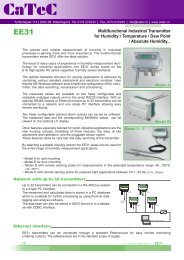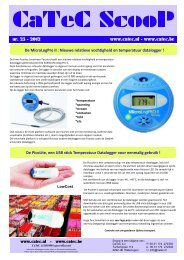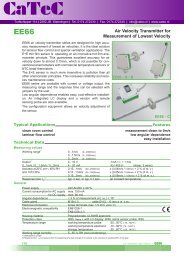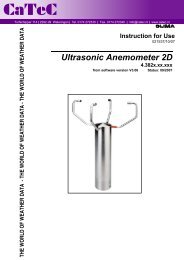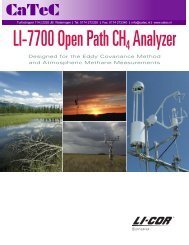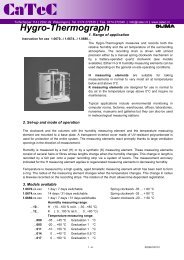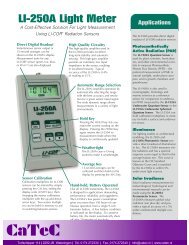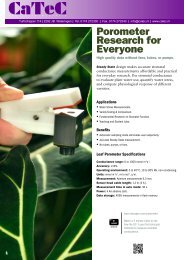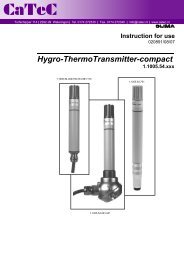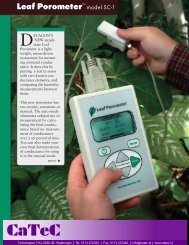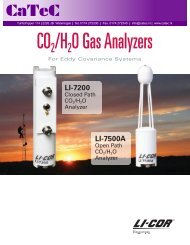li-190sa quantum sensor li-190sa quantum sensor
li-190sa quantum sensor li-190sa quantum sensor
li-190sa quantum sensor li-190sa quantum sensor
Create successful ePaper yourself
Turn your PDF publications into a flip-book with our unique Google optimized e-Paper software.
MATH CHANNELS<br />
The logging and calculation capabi<strong>li</strong>ties of the LI-1400 are<br />
extended by nine math channels. Math channels let you perform<br />
additional logging or math routines using any other current,<br />
voltage or math channel. For example, if you are<br />
logging total daily solar radiation from an LI-200SA<br />
Pyranometer <strong>sensor</strong> connected to current channel #1,<br />
you can also log hourly integrations or averages from<br />
the same <strong>sensor</strong> by adding the channel #1 input to a<br />
math channel and then setting the log routine on the<br />
math channel for hourly integrations. Any of the<br />
math operators or math functions described above can<br />
be used in the math channels as well.<br />
CIRCUITRY<br />
The LI-1400 uses an autoranging, trans-impedance,<br />
chopper stabi<strong>li</strong>zed amp<strong>li</strong>fier for high resolution (8<br />
picoamp), high accuracy measurements of LI-COR radiation<br />
<strong>sensor</strong>s and other <strong>sensor</strong>s with a current output. The high gain<br />
amp<strong>li</strong>fier and unique circuit topology gives an extremely low<br />
input impedance (< 0.03 ohm) to current <strong>sensor</strong>s, resulting in<br />
excellent <strong>li</strong>nearity. Measurement accuracy is enhanced by performing<br />
an auto zero and span before every reading (or once per<br />
minute with 1 second samp<strong>li</strong>ng rate) using a high precision, low<br />
drift reference. A precision sigma-delta analog-to-digital converter<br />
allows high speed, low noise measurements to be made.<br />
Highly accurate, single-ended voltage measurements are<br />
achieved using a precision instrumentation amp<strong>li</strong>fier. Voltage<br />
output transducers with low or high output impedance are accurately<br />
measured because of very high amp<strong>li</strong>fier input impedance.<br />
CURRENT CHANNELS<br />
The LI-1400 has unrivaled resolution for LI-COR radiation <strong>sensor</strong>s.<br />
Current resolution down to 8 picoamps is available<br />
through three sealed BNC connectors and two additional channels<br />
on the 1400-301 Terminal Block.<br />
The three BNC current channels are designed for type "SA"<br />
radiation <strong>sensor</strong>s <strong>li</strong>ke LI-COR's LI-190SA Quantum Sensor,<br />
LI-200SA Pyranometer Sensor or LI-210SA Photometric Sensor.<br />
LI-COR Type "SZ" radiation <strong>sensor</strong>s, with bare wire leads, are<br />
recommended for use with the terminal block.<br />
For other <strong>sensor</strong>s, the LI-1400 can measure current up to ± 250<br />
microamps with very high resolution.<br />
VOLTAGE CHANNELS<br />
Four single-ended voltage channels (± 2.5 VDC) provide high<br />
input impedance for measuring a wide range of <strong>sensor</strong>s,<br />
including LI-COR temperature <strong>sensor</strong>s and humidity <strong>sensor</strong>s.<br />
Voltage measurements require the 1400-301 Terminal Block.<br />
PULSE COUNTING<br />
The LI-1400 has one pulse counting channel for logging total<br />
rainfall from LI-COR's 1400-106 Tipping Bucket Rain Gauge<br />
(or equivalent). The counter channel can be accessed through<br />
the 1400-301 Terminal Block.<br />
ENVIRONMENTAL OPERATION<br />
The LI-1400's rugged, splash resistant case<br />
protects it from exposure to the environment.<br />
Operating temperatures are from<br />
-25 to 55 °C. For operation at remote sites,<br />
the 1400-201 Vented Instrument Enclosure<br />
is recommended to protect <strong>sensor</strong> connections<br />
from rain water and to shade the<br />
LI-1400 from direct sun<strong>li</strong>ght.<br />
The LI-1400 is powered by four "AA"<br />
batteries which provide over 60 hours of<br />
hand-held, instantaneous operation as a<br />
meter. For remote logging app<strong>li</strong>cations, the<br />
1400-402 external "D" cell battery pack<br />
provides over a year of data logging operation from six batteries.<br />
To ensure continuous operation, a low battery warning is<br />
displayed when the batteries are depleted; a <strong>li</strong>thium back-up<br />
battery protects the memory while changing batteries.<br />
While logging data, the LI-1400 conserves battery <strong>li</strong>fe by<br />
operating fully powered only when it must sample a given<br />
channel. After samp<strong>li</strong>ng channels and storing data (if necessary),<br />
the LI-1400 automatically returns to a state of low power<br />
consumption.<br />
DATA STORAGE<br />
The LI-1400 has 96K bytes RAM for data storage. The storage<br />
capacity is dependent on the software configuration.<br />
DATA OUTPUT<br />
Windows 95 ® communication software is included for:<br />
• Rapid binary data transfer<br />
• ASCII data transfer<br />
• Datalogger configuration changes<br />
from the computer.<br />
Stored data can also be transferred to PC-compatible or<br />
Macintosh computers using any terminal program. The LI-1400<br />
data is formatted for easy import into widely used spreadsheet<br />
and database software.<br />
Data can be automatically output via the RS-232 port after<br />
every logging period. When using short logging periods, this<br />
feature allows data capture by a computer with large storage<br />
capacity.<br />
HAND-HELD OPERATION<br />
As an autoranging meter, the LI-1400 provides direct readout for<br />
up to three LI-COR radiation <strong>sensor</strong>s without requiring a<br />
terminal input block.<br />
The output of a given <strong>sensor</strong> can be viewed on the LCD display<br />
11



